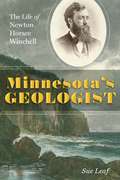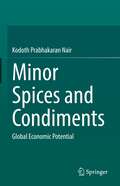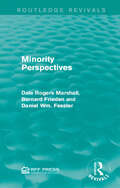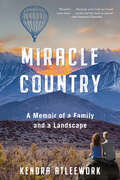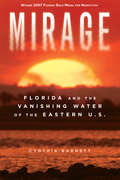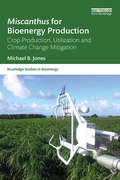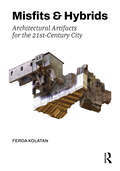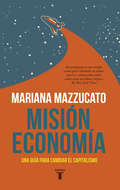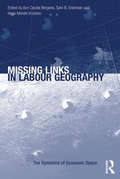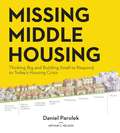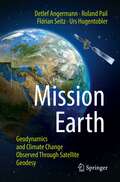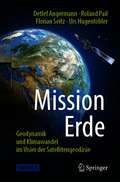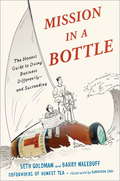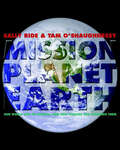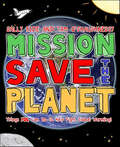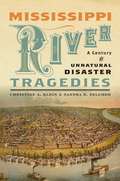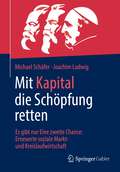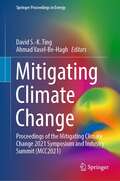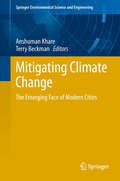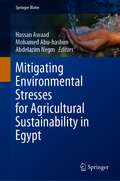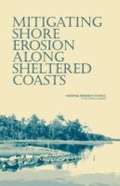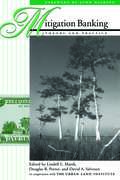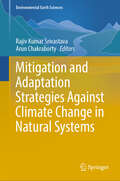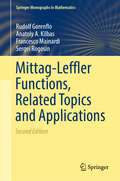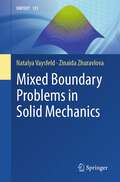- Table View
- List View
Minnesota's Geologist: The Life of Newton Horace Winchell
by Sue LeafWinner of the 2021 Minnesota Book Award for Minnesota Nonfiction The story of the scientist who first mapped Minnesota&’s geology, set against the backdrop of early scientific inquiry in the state At twenty, Newton Horace Winchell declared, &“I know nothing about rocks.&” At twenty-five, he decided to make them his life&’s work. As a young geologist tasked with heading the Minnesota Geological and Natural History Survey, Winchell (1839–1914) charted the prehistory of the region, its era of inland seas, its volcanic activity, and its several ice ages—laying the foundation for the monumental five-volume Geology of Minnesota. Tracing Winchell&’s remarkable path from impoverished fifteen-year-old schoolteacher to a leading light of an emerging scientific field, Minnesota&’s Geologist also recreates the heady early days of scientific inquiry in Minnesota, a time when one man&’s determination and passion for learning could unlock the secrets of the state&’s distant past and present landscape.Traveling by horse and cart, by sailboat and birchbark canoe, Winchell and his group surveyed rock outcrops, river valleys, basalt formations on Lake Superior, and the vast Red River Valley. He studied petrology at the Sorbonne in Paris, bringing cutting-edge knowledge to bear on the volcanic rocks of the Arrowhead region. As a founder of the American Geological Society and founding editor of American Geologist, the first journal for professional geologists, Winchell was the driving force behind scientific endeavor in early state history, serving as mentor to many young scientists and presiding over a household—the Winchell House, located on the University of Minnesota&’s present-day mall—that was a nexus of intellectual ferment. His life story, told here for the first time, draws an intimate picture of this influential scientist, set against a backdrop of Minnesota&’s geological complexity and splendor.
Minor Spices and Condiments: Global Economic Potential
by Kodoth Prabhakaran NairSpices can be classified as major spices, like Black pepper, Cardamom, Turmeric, Ginger etc, and minor spices and condiments, and tree spices. This book will discuss exclusively minor spices and condiments. Spices constitute a very important group of agricultural products, which, since antiquity, have been considered indispensable in the culinary art of flavoring foods. The history of spices is very much entwined with the history of mankind. And, some spice crops like Black pepper predominates in the family of spices. In fact, colloquially, it is called “King”of spices and, another, Cardamom, is called the “Queen”of spices. There is worthwhile amount of published work, on these in addition to Turmeric and Ginger. Both ISO (International Organization for Standardization) and ISI (Indian Standards Institution) (now BIS (Bureau of Indian Standards)) experts concluded, after considerable deliberations, that there is no clear-cut division between “spices” and “çondiments”, and, as such, they have been clubbed together. The term “Spices and Condiments” applies to such natural plant or vegetable products or mixtures, thereof, used in whole or ground form, mainly for imparting flavor, aroma and piquancy to foods and also for seasoning of foods and beverages like soups etc. A detailed survey of published literature proves that there are a number of minor spices, which have tremendous commercial potential, globally. And, an authentic book on these will not only serve as an important guide to the academic community, but, also provide a fillip to industry involved in value addition.
Minority Perspectives (Routledge Revivals)
by Dale Rogers Marshall Bernard Frieden Daniel Wm. FesslerOriginally published in 1972, Minority Perspectives is the second in a series exploring metropolitan problems within the government structure. The 1960’s were a period of civils rights movements as well as poverty in the United States and in the 70’s, it became clear that poverty was closely linked to race. This report sets out to explore issues contributing to the metropolitan-minority poverty problem such as racial exclusion and public policy. The papers included in this report discuss issues such as political power in metropolitan areas, the impact an address can have on economic opportunity for minority groups and the effects that laws and litigation can have on poverty. This title will be of interest to students of environmental and urban studies.
Miracle Country: A Memoir
by Kendra Atleework&“Blending family memoir and environmental history, Kendra Atleework conveys a fundamental truth: the places in which we live, live on—sometimes painfully—in us. This is a powerful, beautiful, and urgently important book.&” —Julie Schumacher, author of Dear Committee Members and The Shakespeare Requirement Kendra Atleework grew up in Swall Meadows, in the Owens Valley of the Eastern Sierra Nevada, where annual rainfall averages five inches and in drought years measures closer to zero. Kendra&’s parents taught their children to thrive in this beautiful, if harsh, landscape, prone to wildfires, blizzards, and gale-force winds. Above all, they were raised on unconditional love and delight in the natural world. After Kendra&’s mother died of a rare autoimmune disease when Kendra was just sixteen, however, her once beloved desert world came to feel empty and hostile, as climate change, drought, and wildfires intensified. The Atleework family fell apart, even as her father tried to keep them together. Kendra escaped to Los Angeles, and then Minneapolis, land of tall trees, full lakes, water everywhere you look. But after years of avoiding her troubled hometown, she realized that she needed to come to terms with its past and present and had to go back. Miracle Country is a moving and unforgettable memoir of flight and return, emptiness and bounty, the realities of a harsh and changing climate, and the true meaning of home. For readers of Cheryl Strayed, Terry Tempest Williams, and Rebecca Solnit, this is a breathtaking debut by a remarkable writer.
Mirage: Florida and the Vanishing Water of the Eastern U.S.
by Cynthia BarnettPart investigative journalism, part environmental history, Mirage reveals how the eastern half of the nation--historically so wet that early settlers predicted it would never even need irrigation--has squandered so much of its abundant fresh water that it now faces shortages and conflicts once unique to the arid West. Florida's parched swamps and supersized residential developments set the stage in the first book to call attention to the steady disappearance of fresh water in the American East, from water-diversion threats in the Great Lakes to tapped-out freshwater aquifers along the Atlantic seaboard. Told through a colorful cast of characters including Walt Disney, Jeb Bush and Texas oilman Boone Pickens, Mirage ferries the reader through the key water-supply issues facing America and the globe: water wars, the politics of development, inequities in the price of water, the bottled-water industry, privatization, and new-water-supply schemes. From its calamitous opening scene of a sinkhole swallowing a house in Florida to its concluding meditation on the relationship between water and the American character, Mirage is a compelling and timely portrait of the use and abuse of freshwater in an era of rapidly vanishing natural resources. Cynthia Barnett, a reporter for Florida Trend magazine, has been a newspaper and magazine journalist for twenty years. Her numerous journalism awards include three investigative-reporting prizes in the Green Eyeshades, which recognize the best journalism in eleven southeastern states. In 2004, she was awarded a Knight-Wallace Fellowship at the University of Michigan, where she spent a year studying freshwater supply. She lives in Gainesville, Florida.
Miscanthus for Bioenergy Production: Crop Production, Utilization and Climate Change Mitigation (Routledge Studies in Bioenergy)
by Michael B. JonesMiscanthus has been enthusiastically promoted as a second generation biomass crop, and this book provides a comprehensive review of this knowledge. Miscanthus, also known as elephant grass, is a high yielding grass crop that grows over three metres tall, resembles bamboo and produces a crop every year without the need for replanting or fertiliser application . The rapid growth, low mineral content, and high biomass yield of Miscanthus increasingly make it a favourite choice as a biofuel, outperforming switchgrass and other alternatives. There is over 20 years of research evidence to support its promotion as a second generation biomass crop. The author reviews many field measurements of yields as well as the physiology of the crop, and why it is so productive while at the same time requiring low inputs to grow it. It also shows how as a key biofuel crop it can contribute to mitigating climate change and how uptake of the adoption of Miscanthus production can be promoted, particularly in Europe and North America. The book will be key reading for students taking courses in the areas of Environmental Science and Engineering, Climate Change Impacts, Renewable Energy and Energy Conservation. It will also be of interest to researchers of second generation biomass crops, and policy developers working in biofuel production and utilization.
Misfits & Hybrids: Architectural Artifacts for the 21st-Century City
by Ferda KolatanContemporary cities are shaped by the unlikely adjacencies of objects that are vastly different in kind, origin, and scale: buildings, infrastructure, and other urban components that over time accumulate into mismatched configurations. However, despite the ubiquity of these oddities and their impact on the city, we rarely give them much consideration. In Misfits & Hybrids, Ferda Kolatan explores the untapped potential in these unexpected conditions for a new kind of architecture. A diverse array of projects, developed in Kolatan’s design studios at the University of Pennsylvania Weitzman School of Design, illustrates how hybrid artifacts can reveal the often overlooked cultural, socio-political, and material histories of a site, fostering design tactics invested in reinventing the existing. Set within the cosmopolitan megacities of Istanbul, Cairo, and New York, the projects are conceived as real fictions, conjuring novel narrative, aesthetic, and representational forms to reflect the pluralistic postindustrial city.
Misión economía: Una guía para cambiar el capitalismo
by Mariana Mazzucato¿Y si aplicáramos a nuestros problemas actuales el espíritu, la audacia y los medios que nos llevaron a la Luna? Una crítica contundente y muy necesaria del capitalismo moderno en la que la galardonada economista internacional sostiene que, para resolver las crisis a las que nos enfrentamos, debemos ser innovadores. Llegar a la Luna fue un extraordinario logro que requirió nuevas formas de colaboración entre los sectores público y privado, un altísimo nivel de compromiso y coordinación y la aceptación de riesgos y gastos muy elevados para alcanzar una meta a largo plazo. Inspirándose en las misiones del programa lunar, Mazzucato propone que se aplique ese mismo nivel de innovación a una serie de objetivos sociales, económicos y políticos clave con el fin de salir de nuestro estancamiento rumbo a un futuro más optimista. El capitalismo lleva tiempo paralizado y no ofrece respuestas a nuestros mayores problemas, como las epidemias, la desigualdad y la crisis ambiental. Se impone la necesidad de repensar el papel de los Estados en la economía y la sociedad, de orientar los presupuestos al largo plazo y de recuperar el sentido del interés público. Misión economía, cuyas ideas ya se están adoptando en todo el mundo, propone fijarse unos objetivos inspiradores e ilusionantes, entre los que se incluyen una prosperidad ampliamente compartida, unos servicios públicos de calidad para todos y una solución a la crisis climática. Según Mazzucato, los Estados pueden afrontar grandes desafíos y misiones ambiciosas, y su visión ofrece una salida a nuestro inmovilismo hacia un futuro más optimista. La crítica ha dicho...«Su propuesta es tan amplia como poco habitual: un nuevo relato convincente sobre cómo crear un futuro deseable.»The New York Times «Su defensa de un nuevo enfoque es abrumadora. Nos contagia con el tipo devisión, ambición e imaginación que tan desesperadamente necesitamos hoy.»The Guardian «Una visión oportuna y optimista. Aunque presenta sus argumentos de manera tan clara que pueden parecer obvios, lo cierto es que son revolucionarios.»Nature «Mazzucato sostiene que las sociedades deben abjurar de ideologías agotadas y adoptar el enfoque político que llevó a los astronautas en la Luna. Convincente y fascinante.»The Economist «Mazzucato critica la pobreza de la idea de que el único papel del gobierno es corregir las "fallas del mercado". Aboga por un sector público capaz de adaptarse a circunstancias cambiantes y nuevos desafíos.»Prospect «Mazzucato propone rediseñar el capitalismo a favor de las partes interesadas más que de los accionistas.»The Times «Desde 1969 nos preguntamos cómo los humanos pudieron llegar a la Luna y no logran resolver los problemas apremiantes aquí en la Tierra. Mariana Mazzucato ofrece la respuesta.»Financial Times «Una de las más ágiles pensadoras post-Brexit.»The Daily Mail «Según Mazzucato, años de privatizar empresas estatales y subcontratar servicios esenciales han dejado a los gobiernos debilitados e incapaces de beneficiar a la sociedad. Es el momento de que respalden objetivos audaces.»Reuters
Missing Links in Labour Geography (The Dynamics of Economic Space)
by Ann Cecilie Bergene Sylvi B. EndresenAddressing a number of 'missing links' in the analysis of labour and its geographies, this volume examines how theoretical perspectives on both labour in general and the organizations of the labour movement in particular can be refined and redefined. Issues of agency, power and collective mobilizations are examined and illustrated via a wide range of case studies from the 'global north' and 'global south' in order to develop a better and fuller appreciation of labour market processes in developed and developing countries.
Missing Middle Housing: Thinking Big and Building Small to Respond to Today's Housing Crisis
by Daniel G. ParolekToday, there is a tremendous mismatch between the available housing stock in the US and the housing options that people want and need. The post-WWII, auto-centric, single-family-development model no longer meets the needs of residents. Urban areas in the US are experiencing dramatically shifting household and cultural demographics and a growing demand for walkable urban living. Missing Middle Housing, a term coined by Daniel Parolek, describes the walkable, desirable, yet attainable housing that many people across the country are struggling to find. Missing Middle Housing types—such as duplexes, fourplexes, and bungalow courts—can provide options along a spectrum of affordability. In Missing Middle Housing, Parolek, an architect and urban designer, illustrates the power of these housing types to meet today's diverse housing needs. With the benefit of beautiful full-color graphics, Parolek goes into depth about the benefits and qualities of Missing Middle Housing. The book demonstrates why more developers should be building Missing Middle Housing and defines the barriers cities need to remove to enable it to be built. Case studies of built projects show what is possible, from the Prairie Queen Neighborhood in Omaha, Nebraska to the Sonoma Wildfire Cottages, in California. A chapter from urban scholar Arthur C. Nelson uses data analysis to highlight the urgency to deliver Missing Middle Housing. Parolek proves that density is too blunt of an instrument to effectively regulate for twenty-first-century housing needs. Complete industries and systems will have to be rethought to help deliver the broad range of Missing Middle Housing needed to meet the demand, as this book shows. Whether you are a planner, architect, builder, or city leader, Missing Middle Housing will help you think differently about how to address housing needs for today's communities.
Mission Earth: Geodynamics and Climate Change Observed Through Satellite Geodesy
by Florian Seitz Roland Pail Detlef Angermann Urs HugentoblerHow does your cell phone know where you are right now? How is our planet changing due to geodynamic processes and ongoing climate change? How can these changes be precisely measured from space in order to obtain reliable information about the melting of ice sheets or the threat to coastal regions from rising sea levels? This popular science book provides answers to these and many other socially relevant questions. It is aimed at interested nonprofessionals who want to learn more about our fascinating planet, but also at experts in natural sciences. You are taken on an exciting journey through time from the first surveys in ancient times to the satellite era, which is providing us with a global view of our home planet. Illustrative examples demonstrate how deeply global positioning and navigation with satellites pervade our daily life, and what fundamental contributions geodesy makes to understanding the Earth system and determining the effects of climate change.With interview contributions by Günter Hein, Harald Lesch and Stefan Rahmstorf. This book is a translation of the original German 1st edition Mission Erde by Detlef Angermann et al., published by Springer-Verlag GmbH Germany, part of Springer Nature in 2021. The translation was done with the help of artificial intelligence (machine translation by the service DeepL.com). Content and language were subsequently revised by the authors. Springer Nature works continuously to further the development of tools for the production of books and on the related technologies to support the authors.
Mission Erde: Geodynamik und Klimawandel im Visier der Satellitengeodäsie
by Florian Seitz Roland Pail Detlef Angermann Urs HugentoblerWoher weiß Ihr Handy, wo Sie gerade unterwegs sind? Wie verändert sich unser Planet aufgrund von geodynamischen Prozessen und dem fortschreitenden Klimawandel? Wie können diese Veränderungen präzise aus dem Weltraum vermessen werden, um verlässliche Aussagen etwa über das Abschmelzen der Eisschilde oder die Bedrohung von Küstenregionen durch den steigenden Meeresspiegel zu erhalten? Das vorliegende Sachbuch gibt Antworten auf diese gesellschaftlich relevanten Fragen. Es richtet sich an interessierte Laien, die mehr über unseren faszinierenden Planeten erfahren wollen, aber auch an Fachexperten naturwissenschaftlicher Disziplinen. Sie werden mitgenommen auf eine spannende Zeitreise von den ersten Vermessungen in der Antike bis in das Zeitalter der Satelliten, die uns die weltweite Bestimmung von extrem genauen Positionen und eine globale Sicht auf unseren Heimatplaneten ermöglichen. Anhand anschaulicher Beispiele wird vermittelt, wie tief die globale Positionierung und Navigation mit Satelliten unseren Alltag durchdrungen haben, und welche fundamentalen Beiträge die Geodäsie als die Wissenschaft von der Vermessung der Erde zum Verständnis des Erdsystems und zur Bestimmung der Auswirkungen des Klimawandels liefert.Mit Interviewbeiträgen von Günter Hein, Harald Lesch und Stefan Rahmstorf
Mission in a Bottle: The Honest Guide to Doing Business Differently--and Succeeding
by Sungyoon Choi Barry Nalebuff Seth GoldmanIn an incredibly fun and accessible two-color graphic-book format, the cofounders of Honest Tea tell the engaging story of how they created and built a mission-driven business, offering a wealth of insights and advice to entrepreneurs, would-be entrepreneurs, and millions of Honest Tea drinkers about the challenges and hurdles of creating a successful business--and the importance of perseverance and creative problem-solving.Seth Goldman and Barry Nalebuff began Honest Tea fifteen years ago with little more than a tea leaf of an idea and a passion to offer organic, freshly brewed, lightly sweetened bottled tea. Today Honest Tea is a rapidly expanding national brand sold in more than 100,0000 grocery stores, restaurants, convenience stores and drugstores across the country. The brand has flourished as American consumers move toward healthier and greener lifestyles.
Mission: Our World And Its Climate--and How Humans Are Changing Them
by Sally Ride Tam O'ShaughnessyFrom an American hero and dedicated scientist: A compelling introduction to the changes taking place in Earth's climate, written for the audience that matters most to our planet's future.Beginning with Sally Ride's unique, astronaut's-eye view of Earth's fragile atmosphere, Mission: Planet Earth describes how water, air, and other climate systems shape our world, and how a disruption in one part of the system can spread through the entire planet. Drawing on the latest scientific research and presenting a clear, even-handed account of the current state of climate studies, illustrated with helpful diagrams and stunning photographs of and from the front lines of climate change, here is a celebration of Earth's natural complexity--and a call to action for a new generation.
Mission: Save the Planet
by Sally Ride Tam O'ShaughnessyPRACTICAL STEPS TO SAVE THE PLANETA how-to companion packed with simple things kids can do to have an impact.From simple measures like turning off the water while you brush your teeth, to bigger challenges like MAKING SOME NOISE in the larger community, this simple guide helps lay a conceptual foundation for kids to become responsible energy consumers in the years to come.
Mississippi River Tragedies: A Century of Unnatural Disaster (Religion, Race, and Ethnicity)
by Christine A Klein Sandra B Zellmer“A stunning and important book. It tells a sweeping tale of folly, greed, ignorance, injustice, and unintended consequences. We all should heed its lessons.” —David Baron, award-winning author of The Beast in the GardenAmerican engineers have done astounding things to bend the Mississippi River to their will: forcing one of its tributaries to flow uphill, transforming over a thousand miles of roiling currents into a placid staircase of water, and wresting the lower half of the river apart from its floodplain. American law has aided and abetted these feats. But despite our best efforts, so-called “natural disasters” continue to strike the Mississippi basin, as raging floodwaters decimate waterfront communities and abandoned towns literally crumble into the Gulf of Mexico. In some places, only the tombstones remain, leaning at odd angles as the underlying soil erodes away. Mississippi River Tragedies reveals that it is seductively deceptive—but horribly misleading—to call such catastrophes “natural.”Authors Christine A. Klein and Sandra B. Zellmer present a sympathetic account of the human dreams, pride, and foibles that got us to this point, weaving together engaging historical narratives and accessible law stories drawn from actual courtroom dramas. The authors deftly uncover the larger story of how the law reflects and even amplifies our ambivalent attitude toward nature—simultaneously revering wild rivers and places for what they are, while working feverishly to change them into something else. Despite their sobering revelations, the authors’ final message is one of hope. Although the acknowledgement of human responsibility for unnatural disasters can lead to blame, guilt, and liability, it can also prod us to confront the consequences of our actions, leading to a liberating sense of possibility and to the knowledge necessary to avoid future disasters.
Mit Kapital die Schöpfung retten: Es gibt nur Eine zweite Chance: Erneuerte soziale Markt- und Kreislaufwirtschaft
by Michael Schäfer Joachim LudwigDie biblische Prophezeiung der Apokalypse droht real zu werden. Das ist den meisten zwar bewusst. Aber die halbherzigen Maßnahmen zur Verhinderung des Untergangs konzentrieren sich zudem „nur“ auf die drohende Klimakatastrophe. Gewaltiges Gefährdungspotenzial haben auch der ruinöse Raubbau an den dramatisch schrumpfenden irdischen Ressourcen und die Vermüllung weiter Teile der Erde. Anerkannte Experten sagen voraus, dass der Kollaps der für das Leben wesentlichen Ökosysteme wie die Weltmeere und tropischen Regenwälder kaum noch zu verhindern ist. Dieses Buch entwickelt eine ebenso radikale wie einfache Formel zur Rettung der Schöpfung. Das "Zauberwort" heißt Kreislaufwirtschaft, wozu auch die Erneuerbaren Energien gehören. Alle Stoffe, die in die Wertschöpfungskette eingehen, müssen nach dem Lebenszyklus der Produkte komplett zurückgewonnen werden. Das wäre für alle bezahlbar, und wir verfügen auch über das nötige Know-how. Was wir brauchen, ist „nur“ ein Verursacherprinzip für die Rückgewinnung und eine Marktwirtschaft, für die wir das Soziale viel umfassender und vor allem einklagbar definieren. Dies wird von den Autoren erstmals theoretisch entwickelt. Dazu präsentieren sie praktikable Vorschläge zur politischen Umsetzung.Schlagkräftige Argumente liefert ein (fiktives) Interview der Autoren mit Papst Franziskus, Karl Marx und Friedrich Engels. Die drei antworten mit Aussagen aus ihren Schriften auf gleichlautende Fragen. Was verblüfft und beeindruckt, sind die großen Übereinstimmungen in den Bestandsaufnahmen und Lösungsvorschlägen.
Mitigating Climate Change: Proceedings of the Mitigating Climate Change 2021 Symposium and Industry Summit (MCC2021) (Springer Proceedings in Energy)
by David S.-K. Ting Ahmad Vasel-Be-HaghThis book includes the proceedings of the Mitigating Climate Change 2021 Symposium and Industry Summit (MCC2021), which brings together research from experts in academia, industry, and policy arenas to uncover the challenges, sharpen existing solutions, and formulate cutting-edge means to mitigate climate change. It highlights the need to create sustainable measures at all fronts including adaptation, policy, finance, renewable energy, solar, wind, thermoelectric, green transportation, and sustainable healthcare. This symposium will disseminate the state-of-the-art breakthroughs and promote collaborations to maximize opportunities for innovative solutions.
Mitigating Climate Change: The Emerging Face of Modern Cities
by Anshuman Khare Terry BeckmanWith ever increasing trends in urban consumption and production practices, a call for action to mitigate Climate Change is often seen as a way to foster sustainable development. Considerable attention is now being paid to determine what urban sustainability would include. Today there is a pressing need to broaden our knowledge and apply new concepts and frameworks to development of modern cities. Building on the foregoing, this book attempts to bring together and discuss concepts, tools, frameworks and best practices to cope with the emerging challenges faced by cities today. The book will be of use to policy makers, city planners, practitioners and academics who are starting to project what modern cities would need to do in terms of energy efficiency, mobility, planning and design of habitat and infrastructure and adapting to climate change.
Mitigating Environmental Stresses for Agricultural Sustainability in Egypt (Springer Water)
by Mohamed Abu-Hashim Hassan Awaad Abdelazim NegmThis book focuses on the soil and environmental resources and how to utilize them under Egyptian conditions to achieve tolerance to environmental abiotic stresses, i.e., drought, heat, salt, pollutants, and biotic stresses such as disease resistance. Further, it explores ways to increase productivity, improve the quality of field crops, and reduce the food gap. The application of modern technologies is an essential mechanism for improving crops' productivity through laser, seed technology, mycorrhiza, and biotechnology to enhance the yield of genotypes in sustainable farming systems. Therefore, this book discusses fundamental ways to increase productivity under various environmental circumstances. The book reflects the enormous potential held by horizontal expansion in the newly reclaimed lands in Egypt. Tapping that potential depends on developing crops that are highly tolerant to environmental stresses and mitigating the impacts of climate changes around the world to help Egypt and countries with similar weather and water deficits achieve the 2030 sustainability agenda for agriculture. Given its profundity and scope, the book offers a valuable asset for stakeholders, policy planners, decision-makers, researchers, and scientists in Egypt and worldwide.
Mitigating Shore Erosion Along Sheltered Coasts
by National Research Council of the National AcademiesLike ocean beaches, sheltered coastal areas experience land loss from erosion and sea level rise. In response, property owners often install hard structures such as bulkheads as a way to prevent further erosion, but these structures cause changes in the coastal environment that alter landscapes, reduce public access and recreational opportunities, diminish natural habitats, and harm species that depend on these habitats for shelter and food. Mitigating Shore Erosion Along Sheltered Coasts recommends coastal planning efforts and permitting policies to encourage landowners to use erosion control alternatives that help retain the natural features of coastal shorelines.
Mitigation Banking: Theory And Practice
by Douglas R. Porter David Salvesen John De Grove Lindell L. MarshUnder the Clean Water Act, development that results in the permanent destruction of wetlands must, in most cases, be mitigated by the creation of a new wetland or the restoration of a degraded one. In recent years, the concept of "mitigation banking" has emerged. Rather than require developers to create and maintain wetlands on their own on a quid pro quo basis, mitigation banking allows them to pay for wetlands that have been created and maintained properly by others to compensate for their damage.The contributors to this volume provide an overview of mitigation banking experience in the United States, examine the key issues and concerns -- from providing assurances to determining the value of credits -- and describe the practice of developing and operating a mitigation bank. Topics include: history and current experience of mitigation banking policies and concerns of local, state, and federal agencies economics of mitigation banking funding, management, and operation of banks starting a mitigation bank
Mitigation and Adaptation Strategies Against Climate Change in Natural Systems (Environmental Earth Sciences)
by Rajiv Kumar Srivastava Arun ChakrabortyThis book addresses strategies for mitigating and adapting to climate change in natural systems. According to the IPCC (2021) report, human-induced climate change has widespread global effects, significantly impacting natural ecosystems. Extreme weather events linked to climate change harm terrestrial, freshwater, ocean, and coastal ecosystems, reduce food security, displace populations, damage livelihoods, health, and security, and exacerbate inequality. While the impacts of climate change are vast and varied, making it impossible to cover every sector, the authors have aimed to address key areas and offer strategies for combating climate change through mitigation and adaptation. The book is structured into five sections: • Land (agriculture, horticulture, soil, forest) • Water (rivers, lakes) • Atmosphere (hydrology, climate) • Technologies/Approaches (remote sensing, GIS, AI tools, ChatGPT) • Case Studies (crops, forests, soil glomalin application, eco-friendly fertilizers), with a focus on modelling approaches to assess these strategies. Additionally, the authors reviewed related works on climate change mitigation and adaptation, identifying a gap in using newer technologies and approaches. The book also covers topics such as water quality and the analysis of several greenhouse gases such ad NO2, O3, CO2 and CH4 in the environment. This book will be beneficial for students, educators, professionals, researchers, policymakers, and farmers. It provides content ranging from introductory to advanced levels, making it accessible to those working in environmental science.
Mittag-Leffler Functions, Related Topics and Applications (Springer Monographs in Mathematics)
by Rudolf Gorenflo Anatoly A. Kilbas Francesco Mainardi Sergei RogosinThe 2nd edition of this book is essentially an extended version of the 1st and provides a very sound overview of the most important special functions of Fractional Calculus. It has been updated with material from many recent papers and includes several surveys of important results known before the publication of the 1st edition, but not covered there.As a result of researchers’ and scientists’ increasing interest in pure as well as applied mathematics in non-conventional models, particularly those using fractional calculus, Mittag-Leffler functions have caught the interest of the scientific community. Focusing on the theory of Mittag-Leffler functions, this volume offers a self-contained, comprehensive treatment, ranging from rather elementary matters to the latest research results. In addition to the theory the authors devote some sections of the work to applications, treating various situations and processes in viscoelasticity, physics, hydrodynamics, diffusion and wave phenomena, as well as stochastics. In particular, the Mittag-Leffler functions make it possible to describe phenomena in processes that progress or decay too slowly to be represented by classical functions like the exponential function and related special functions.The book is intended for a broad audience, comprising graduate students, university instructors and scientists in the field of pure and applied mathematics, as well as researchers in applied sciences like mathematical physics, theoretical chemistry, bio-mathematics, control theory and several other related areas.
Mixed Boundary Problems in Solid Mechanics (UNITEXT #155)
by Natalya Vaysfeld Zinaida ZhuravlovaThe book covers a wide range of subjects and techniques related to mixed boundary problems of elasticity from basic concepts to special techniques that are unlikely to appear in traditional university graduate courses. This book may also be of interest to industrial researchers who encounter defects such as cracks and inclusions of different materials in mechanisms under different localization and type of loading. So the topics present the application of mathematical mechanics of solid bodies notably in elasticity, showing the interconnection of elasticity and temperature that would normally treated independently. Theoretical and experimental results are expected to be useful for researchers investigating a wide range of materials including metals, composites, ceramics, polymers, biomaterials and nanomaterials under different mechanical and temperature loading. The aim of the book is to introduce an interdisciplinary audience to a variety of stress state phenomena occurring in elasticity near defects and edges of the bodies. The book is aimed at researchers, primarily but not exclusively graduate students, postdoctoral researchers, specialists from Aerospace and Civil Engineering, Materials Science, and Engineering Mechanics and should naturally also be of interest to specialists of Physics and Applied Mathematics.
